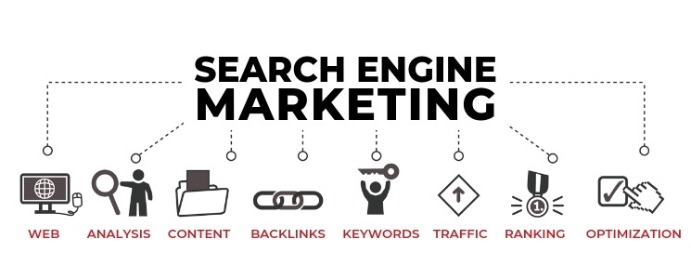lucy hale's blog : How Web Design Sites Manipulate Search Engine Rankings?

Search Engine Marketing Company in India - In the competitive world of digital marketing, achieving high search engine rankings is crucial for attracting traffic and, consequently, customers. While reputable websites use ethical strategies to improve their search engine optimization (SEO), some web design sites resort to manipulative techniques to climb the search engine results pages (SERPs). These tactics can often violate search engine guidelines and provide a subpar experience for users. Understanding these manipulative techniques is essential for both webmasters aiming to protect their sites and users seeking to avoid questionable websites. Here’s an in-depth look at how web design sites manipulate search engine rankings.
- Keyword Stuffing
Keyword stuffing involves overloading a webpage with keywords or numbers in an attempt to manipulate a site's ranking in Google's search results. Often, these keywords appear out of context or in unnatural sentences, disrupting the flow of the content. For example, a web design site might repeatedly use phrases like "best web design" or "cheap web design services" throughout a page, regardless of relevance to the actual content.
How It Works:
- High Keyword Density: The site includes an excessive number of keywords in the meta tags, headings, and body text.
- Hidden Text: Keywords are sometimes hidden from users but visible to search engines by matching the text color to the background color.
Consequences:
- User Experience: This practice leads to poor readability and user experience.
- Penalties: Search engines, particularly Google, penalize sites caught keyword stuffing, which can result in lower rankings or removal from search results.
- Cloaking
Cloaking involves presenting different content or URLs to human users and search engines. This deceptive tactic aims to improve search rankings by showing search engines optimized content that users never see.
How It Works:
- Content Switch: The server delivers one version of a page to search engine crawlers and a completely different version to users.
- IP-Based Cloaking: The site detects whether a visitor is a search engine crawler or a regular user based on IP address and serves content accordingly.
Consequences:
- Misleading Users: Users end up on pages that do not provide the information they were promised.
- Severe Penalties: Search engines consider cloaking a serious violation, often leading to significant penalties or complete removal from the index.
- Link Schemes
Backlinks are a critical component of SEO, as they signal to search engines that a site is authoritative and trustworthy. web design sites often engage in link schemes to artificially inflate the number of backlinks pointing to their site.
How It Works:
- Buying Links: Purchasing links from other websites, which can be part of link farms or private blog networks (PBNs).
- Reciprocal Links: Arranging mutual linking agreements with other sites, irrespective of relevance.
- Spam my Comments: Posting links in the comment sections of blogs or forums without contributing meaningful content.
Consequences:
- Devalued Links: Search engines devalue or ignore backlinks from known link schemes.
- Reputation Damage: Participation in link schemes can harm a site's reputation and lead to penalties.
- Duplicate Content
Duplicate content refers to blocks of content that completely match other content across different websites or within the same site. web design sites often scrape content from reputable sources to populate their pages quickly.
How It Works:
- Scraping: Copying content from other websites without permission.
- Spinning: Using software to slightly modify copied content to make it appear unique.
Consequences:
- Search Engine Penalties: Duplicate content can lead to lower rankings or removal from search results.
- Credibility Issues: Users who recognize copied content may view the site as untrustworthy.
- Private Blog Networks (PBNs)
PBNs are networks of websites created specifically to build backlinks to a single main site to manipulate its ranking. These sites often contain low-quality content and are interlinked to pass authority to the target site.
How It Works:
- Multiple Sites: Creating numerous interconnected websites.
- Controlled Links: Each site in the network links to the main site to boost its backlink profile.
Consequences:
- Risk of Detection: Search engines are adept at identifying PBNs, leading to de-indexation.
- Resource Intensive: Maintaining a PBN requires significant effort and resources.
- Negative SEO
Negative SEO involves using unethical practices to sabotage competitors' rankings rather than improve one's own. This can include building harmful backlinks to a competitor's site, hacking their site, or duplicating their content.
How It Works:
- Harmful Backlinks: Creating spammy or toxic backlinks to a competitor’s site.
- Content Duplication: Copying and distributing a competitor’s content across multiple sites to create duplicate content issues.
DDoS Attacks: Disrupting a competitor’s site availability through Distributed Denial of Service attacks.
Consequences:
- Ethical Violations: Negative SEO is highly unethical and can lead to severe legal consequences.
- Temporary Gains: Any short-term benefits are outweighed by long-term risks, including potential retaliation.
- Clickbait and Misleading Titles
Using clickbait involves creating sensationalized or misleading titles to attract clicks. While this can temporarily boost traffic, it often leads to high bounce rates and user dissatisfaction.
How It Works:
- Sensational Headlines: Crafting titles that promise more than the content delivers.
- Irrelevant Keywords: Using trending but irrelevant keywords in titles to attract clicks.
Consequences:
- High Bounce Rates: Users quickly leave the site when they realize the content doesn’t match the headline.
- Search Engine Adjustments: Search engines use bounce rates as a ranking signal, which can negatively impact the site's rankings.
Conclusion
Web design sites often resort to manipulative techniques to achieve high search engine rankings, compromising the quality and integrity of the web. While these tactics might yield short-term gains, they usually result in long-term penalties and reputational damage. Ethical SEO practices, focusing on quality content and genuine user engagement, remain the most sustainable approach for achieving and maintaining high search engine rankings. For users, recognizing these manipulative tactics can help in avoiding low-quality sites and finding the most relevant and reliable information online.
Search Engine Optimization in Delhi involves optimizing websites to improve their visibility on search engines like Google. This includes keyword research, on-page optimization, content creation, and link building tailored to the local market. SEO services in Delhi cater to businesses seeking to increase online presence and attract more local customers. With a focus on both global and local SEO strategies, Delhi-based agencies help businesses achieve higher rankings, drive organic traffic, and enhance overall digital marketing efforts.
In:- Digital



